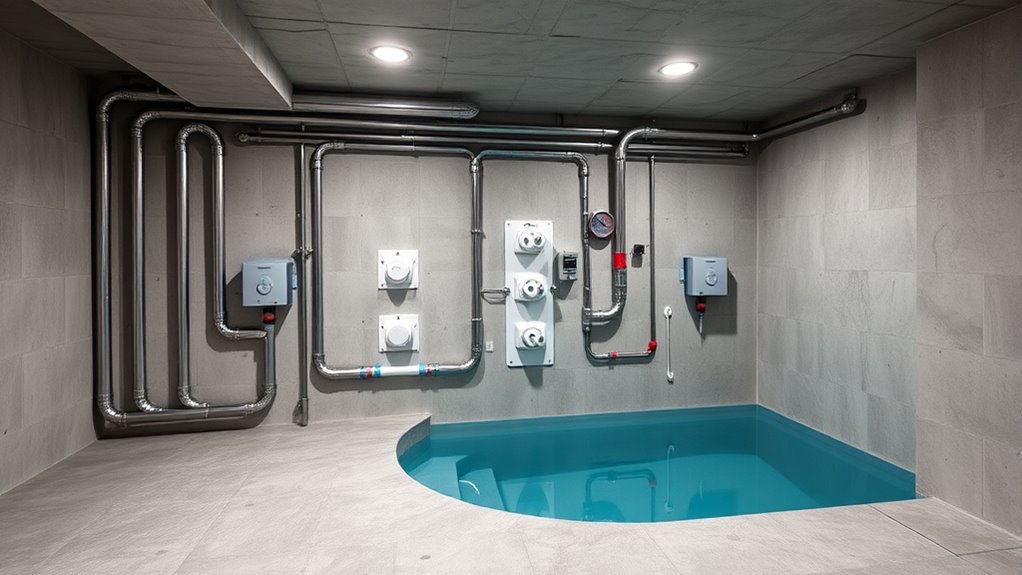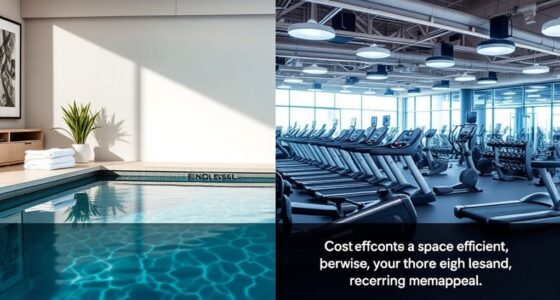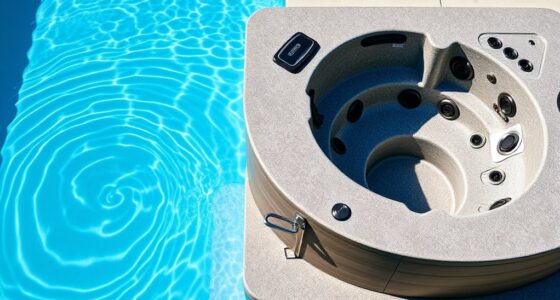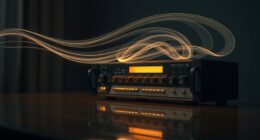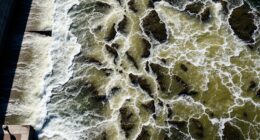To set up your endless pool safely, guarantee you have a dedicated electrical circuit with the appropriate breaker size and GFCI protection to prevent shocks. Properly ground and bond all metal components, and use waterproof conduit to protect wiring. For plumbing, connect water supply lines and drainage securely with corrosion-resistant fittings. Follow local codes and permit requirements, and test your system thoroughly. Continuing with these steps will help you confidently complete a safe and efficient setup.
Key Takeaways
- Ensure a dedicated, GFCI-protected electrical circuit with proper breaker sizing and grounding for safety and code compliance.
- Use organized, secure plumbing connections with corrosion-resistant materials, properly sized fittings, and regular leak inspections.
- Plan wiring path to minimize voltage drop, protect wiring from moisture, and follow local electrical codes and manufacturer guidelines.
- Obtain necessary permits, conduct system inspections, and verify all electrical and plumbing connections before filling the pool.
- Conduct thorough testing of electrical and plumbing systems for leaks, proper operation, and safety features before regular use.
Assessing Electrical Requirements for Your Endless Pool
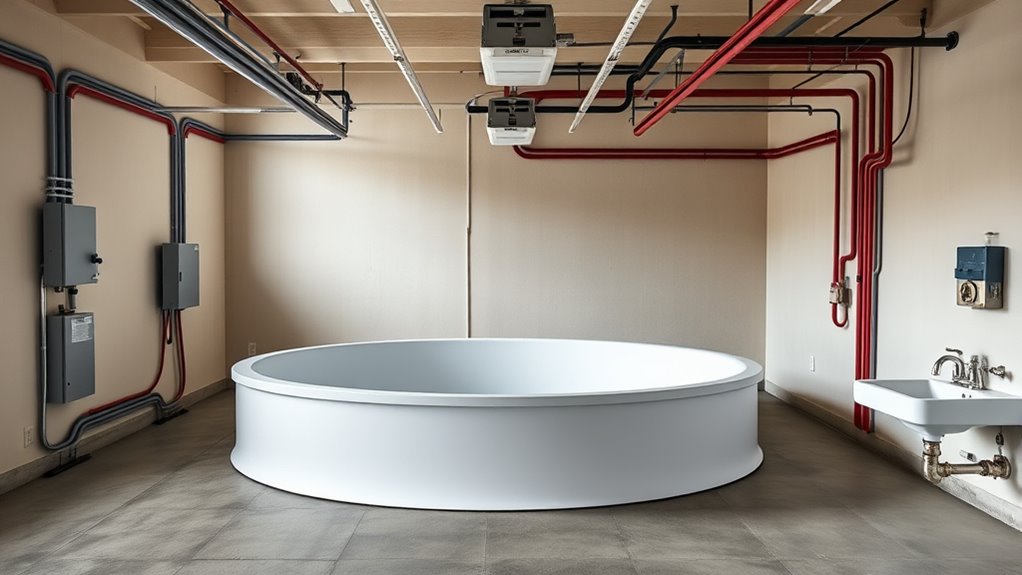
Before installing your endless pool, it’s essential to ascertain its electrical needs to guarantee safe and reliable operation. Start by reviewing the pool’s specifications to determine the voltage and amperage requirements. Most pools need a dedicated circuit to prevent overloads and ensure consistent power delivery. Check the manufacturer’s guidelines for recommended wiring and circuit breaker sizes. You’ll also need to consider the distance from your main electrical panel to the pool area, as longer runs may require thicker wiring to prevent voltage drops. Installing a GFCI (ground-fault circuit interrupter) outlet or breaker is crucial for safety, protecting you from electrical shocks. Proper assessment now helps avoid costly adjustments later and guarantees your pool operates smoothly and safely. Additionally, understanding electrical requirements can help ensure compliance with local codes and prevent potential hazards.
Selecting the Appropriate Power Supply and Circuit Breakers
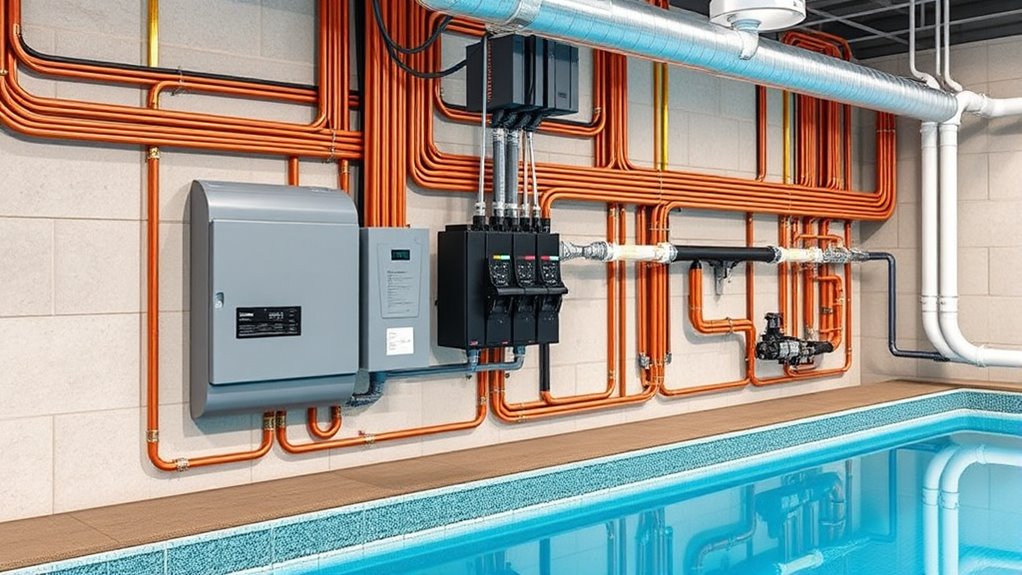
Choosing the right power supply and circuit breakers is essential to guarantee your endless pool operates safely and efficiently. First, determine the pool’s electrical load by checking the manufacturer’s specifications. This will inform you of the voltage and amperage requirements. Ensure your circuit breaker matches these specs to protect your system from overloads or faults. For most pools, a dedicated circuit is recommended, preventing interference from other appliances. Use a circuit breaker rated slightly above the maximum load to provide proper protection without nuisance tripping. Additionally, consider using a GFCI (Ground Fault Circuit Interrupter) breaker, which quickly cuts power if a ground fault occurs, reducing shock risks. Properly selecting and installing these components keeps your pool safe and compliant with electrical codes. Recognizing the importance of proper electrical safety can help prevent accidents and damage.
Proper Grounding and Bonding Procedures
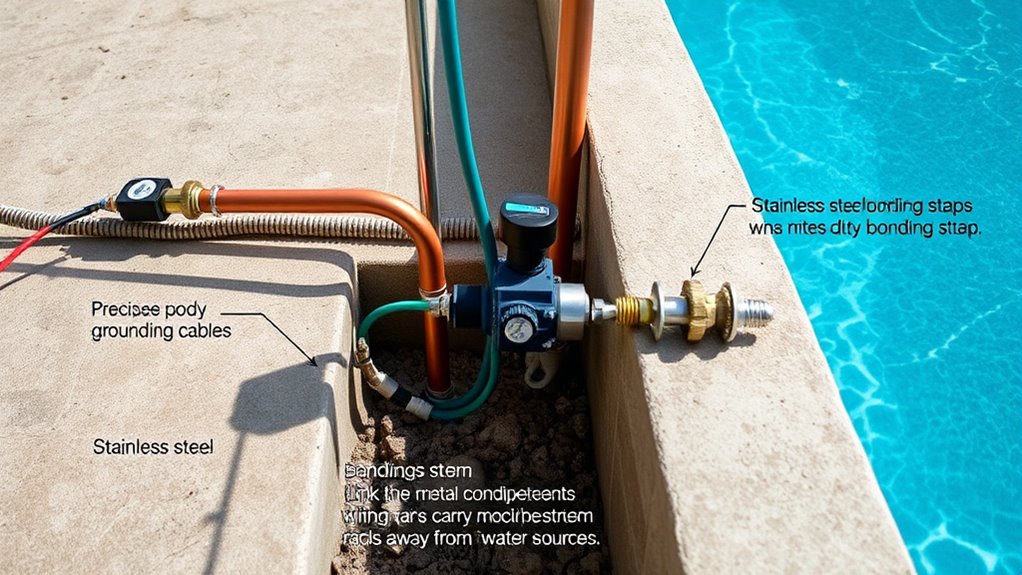
Once you’ve selected the right electrical components, guaranteeing proper grounding and bonding is essential for safety and system integrity. Grounding involves connecting your pool’s electrical system to a grounded metal rod or grounding system to prevent electrical shocks. Bonding ensures all metal components, like the pool’s shell, plumbing, and electrical equipment, are connected with a continuous conductor, maintaining the same electrical potential. Use a grounding rod or wire to connect the system to the earth, and bond all metallic parts with a copper wire or bonding strap. Check local codes and manufacturer instructions to meet specific requirements. Proper grounding and bonding reduce the risk of electrical shock, protect equipment, and ensure compliance with safety standards. Always verify your setup before powering up your pool system.
Installing a Dedicated Electrical Circuit
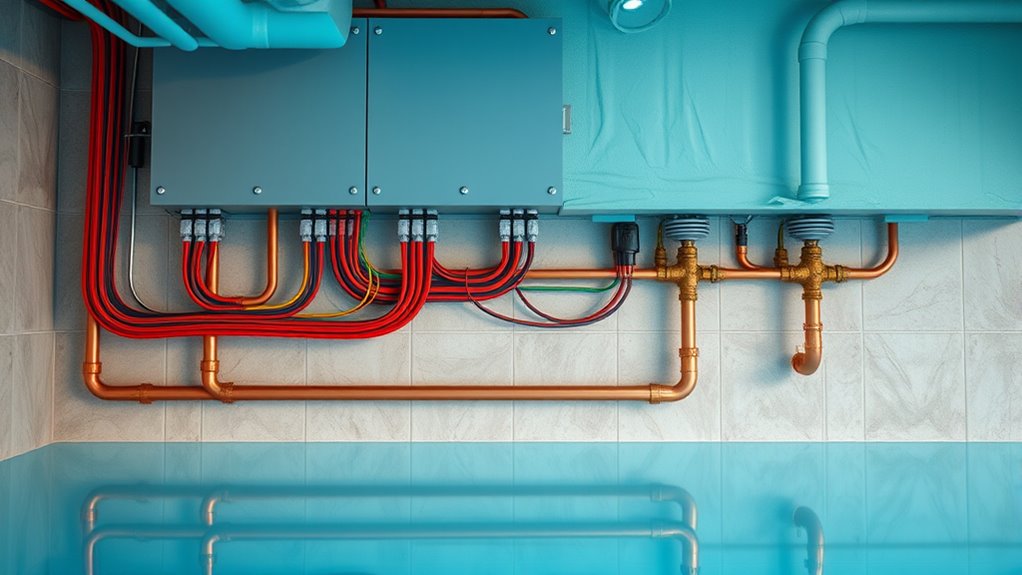
When installing a dedicated electrical circuit for your Endless Pool, you’ll need to take into account the circuit capacity to handle the load safely. Proper placement is also key to guarantee easy access and compliance with electrical codes. Making these choices carefully helps prevent future issues and keeps your setup running smoothly. Additionally, considering home theatre projectors and their specific power requirements can ensure your entire entertainment setup operates efficiently without overloading the circuit.
Circuit Capacity Requirements
To guarantee your Endless Pool operates safely and efficiently, installing a dedicated electrical circuit is essential. The circuit must handle the pool’s power demands without overloading. Typically, a 50-amp circuit is recommended for standard pools, but larger models might require 60 amps or more. Check your pool’s specifications to determine the exact capacity needed. Failing to match the circuit capacity can cause frequent breaker trips or potential electrical hazards. Use the table below to compare common circuit sizes and their suitable pool sizes:
| Circuit Size | Pool Size Compatibility | Typical Breaker Size |
|---|---|---|
| 30 amps | Small pools | 30 amps |
| 50 amps | Standard pools | 50 amps |
| 60 amps | Large or high-power pools | 60 amps |
| 70+ amps | Commercial pools | 70+ amps |
Ensuring the circuit is properly sized for your pool helps prevent electrical issues and promotes safe operation.
Proper Circuit Placement
Proper circuit placement involves choosing a dedicated spot close to your pool’s location to install the electrical line. You want this spot to be easily accessible and protected from weather elements. Avoid placing the circuit too far from the pool to reduce voltage drop and wiring costs. Confirm the location complies with local electrical codes and safety standards. Consider installing the circuit breaker and GFCI outlet nearby for quick access and safety. Keep the wiring path clear of obstructions and avoid placing it near water sources or potential hazards. Proper placement minimizes the risk of electrical issues and simplifies future maintenance. Planning ahead ensures your Endless Pool operates safely and efficiently, giving you peace of mind and a seamless setup process. Additionally, understanding sound design principles can help in planning electrical systems to minimize noise and electromagnetic interference for a quieter environment.
Wiring the Pool Pump and Heater Safely
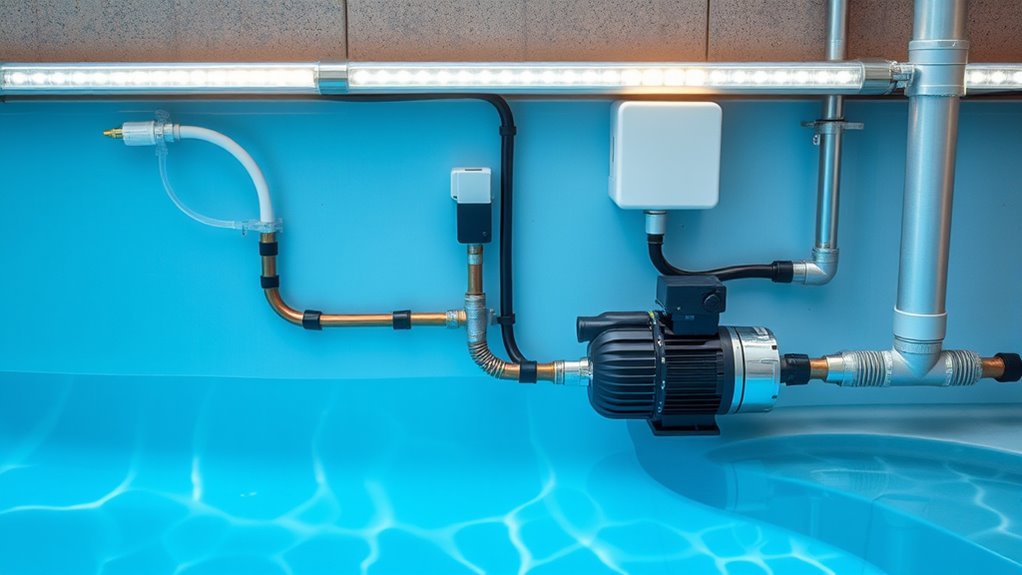
Guaranteeing safe wiring for your pool pump and heater is crucial to prevent electrical hazards and assure reliable operation. Proper wiring ensures safety and efficiency, protecting you and your equipment. Always use a Ground Fault Circuit Interrupter (GFCI) outlet or breaker to cut power during a fault. Keep wiring protected from moisture and physical damage by using waterproof conduit and proper insulation. Verify that all connections are tight and secure to prevent arcing or overheating. Follow local electrical codes and manufacturer instructions for each component. Use dedicated circuits for your pump and heater to avoid overloads. Regularly inspect wiring for signs of wear or damage, and replace any compromised components immediately. Proper wiring setup keeps your pool safe, operational, and enjoyable year-round. Additionally, understanding security zone info can help you implement safety measures around your pool area to prevent unauthorized access and ensure overall safety.
Plumbing Layout and Pipe Sizing Considerations
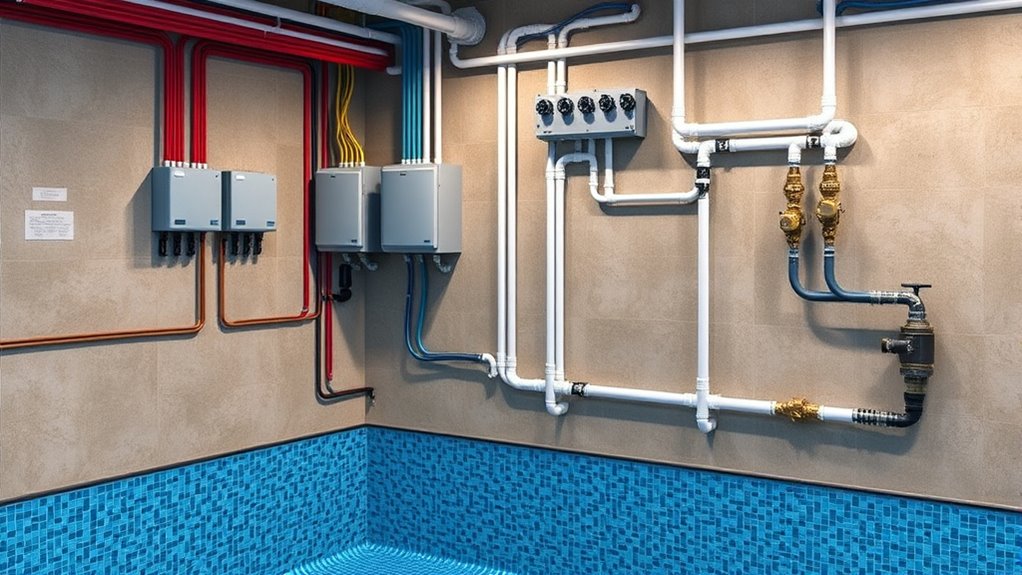
A well-designed plumbing layout is essential for efficient water flow and easy maintenance in your Endless Pool. Proper pipe sizing prevents pressure loss and ensures smooth operation. Use larger pipes for main lines to handle flow demands, typically 1.5 to 2 inches in diameter. Smaller pipes, like 1 inch, are suitable for branch lines. Keep pipe runs as straight as possible to minimize friction and flow restriction. Incorporating beneficial ingredients like collagen and hyaluronic acid in your system can improve overall water quality and equipment longevity. Plan your layout to avoid sharp bends and obstructions. Proper pipe sizing and layout optimize performance and simplify future maintenance.
Connecting Water Supply Lines and Drainage Systems
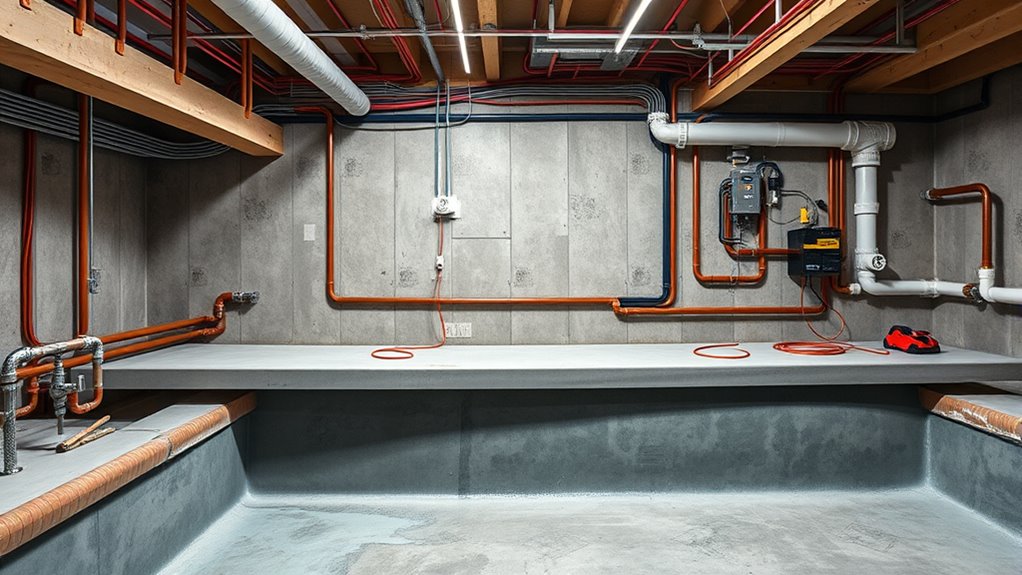
Connecting your water supply lines and drainage system is a critical step to guarantee your Endless Pool functions efficiently and safely. Proper connections ensure consistent water flow and prevent leaks that could damage your setup. You’ll need to select appropriate fittings and secure them tightly to avoid pressure issues. Make sure your supply lines are the right size for your pool’s needs, and install drainage outlets to handle overflow or maintenance draining. It’s vital to test all connections before filling the pool to catch leaks early. Use durable, corrosion-resistant materials for longevity. Keep in mind that neat and organized piping reduces future troubleshooting. Properly connecting these systems provides peace of mind and ensures your pool remains a safe, enjoyable retreat. Additionally, verifying the integrity of your connections and fittings helps prevent potential water damage or system failure.
Ensuring Compliance With Local Codes and Permits
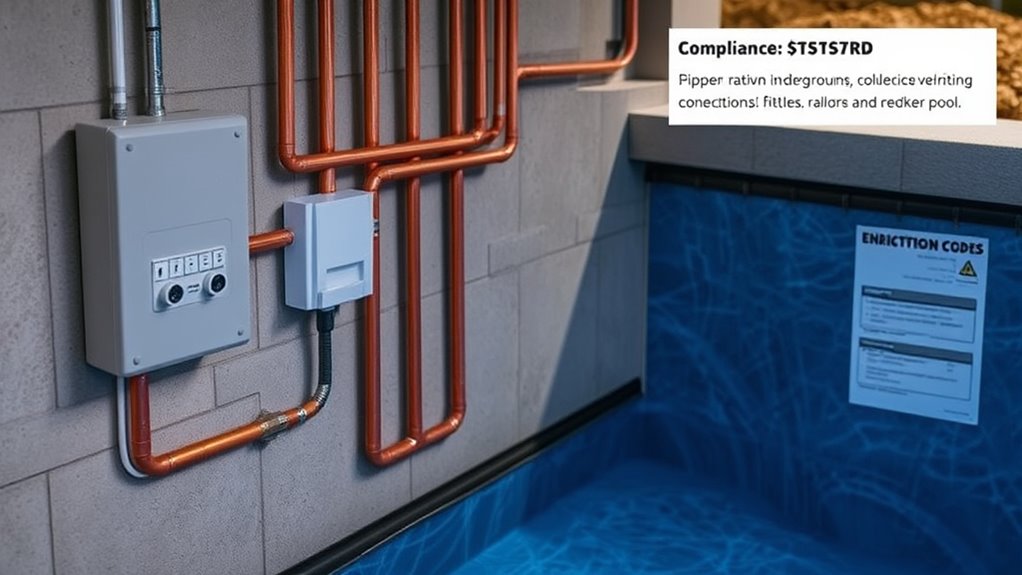
Before filling your pool and turning on the systems, it’s important to make certain your installation meets all local codes and permits. Check with your city or county building department for specific requirements related to electrical wiring, plumbing, and safety standards. Obtain any necessary permits before starting work to avoid fines or future compliance issues. Review local regulations on GFCI outlets, circuit breaker ratings, and distance from water sources. Confirm all electrical installations are inspected and approved by licensed professionals. Keep documentation of permits and inspections for your records. Adhering to local codes not only keeps you compliant but also ensures your pool is safe and reliable. Skipping this step could lead to legal problems or costly modifications down the line. Understanding local water quality standards can help inform your setup choices and prevent issues down the road.
Testing and Troubleshooting Electrical and Plumbing Connections
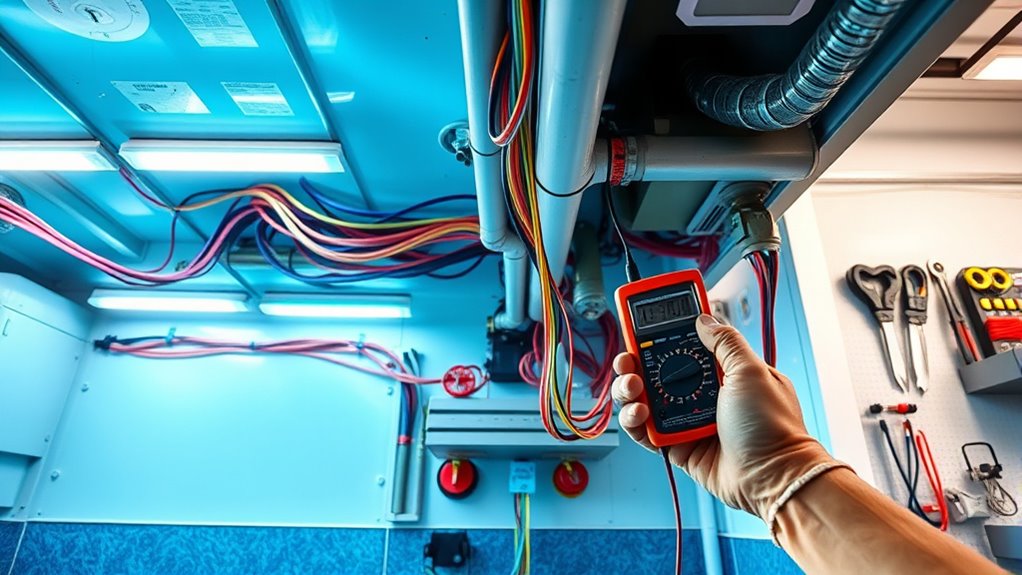
Once your electrical and plumbing connections are in place, it is crucial to thoroughly test each system to guarantee everything functions correctly and safely. Start by turning on the power and checking for any unusual sounds or sparks. Inspect plumbing connections for leaks or drips, ensuring all fittings are tight. Use a multimeter to verify voltage levels and proper grounding. Run the pump and heater to confirm they operate smoothly without interruptions. Pay close attention to water circulation and temperature stability. Additionally, review your materials and fuel primers to ensure compatibility and safety before ongoing use.
- Check for leaks around all fittings and joints
- Confirm electrical grounding and circuit safety
- Test the pump and heater for consistent operation
- Inspect for any abnormal noises or vibrations
Frequently Asked Questions
How Often Should I Inspect Electrical Connections for Safety?
You should inspect your electrical connections at least once every three to six months to guarantee safety. Regular inspections help you catch loose or corroded wires, signs of wear, or any potential hazards early. Always turn off the power before checking, and if you’re unsure or notice any issues, hire a qualified electrician. Staying proactive keeps your pool safe and functioning smoothly for years to come.
What Are Common Signs of Plumbing Leaks in the Setup?
You should watch for signs like water pooling around the pool or equipment, unexplained drops in water level, damp or moldy spots nearby, or a sudden increase in your water bill. Listen for dripping sounds or hissing noises that indicate leaks. If you notice any of these signs, it’s best to inspect your plumbing connections promptly and consider calling a professional to prevent further damage.
Can I Install the Electrical Components Myself or Hire a Professional?
You can install electrical components yourself if you have experience with electrical work and follow local codes, but it’s safest to hire a professional. Electrical systems for pools involve complex wiring and safety considerations that require proper certification. Hiring a licensed electrician guarantees the job gets done correctly and reduces risks of electrical hazards. When in doubt, always opt for professional installation to guarantee safety and compliance.
Are There Specific Materials Recommended for Pool Plumbing Pipes?
Did you know that using the right plumbing pipes can extend your pool’s lifespan by up to 30%? For your Endless Pool, you should opt for schedule 40 PVC pipes, which are durable and resistant to corrosion. Avoid cheap or flexible hoses, as they can leak or burst under pressure. Always choose materials specifically rated for swimming pool use, ensuring safety and longevity.
How Do I Ensure My Setup Meets All Local Safety Regulations?
You guarantee your setup meets local safety regulations by consulting your local building codes and pool safety standards first. Obtain permits if needed, and work with licensed professionals for electrical and plumbing installations. Regularly inspect your setup, follow manufacturer guidelines, and use approved materials. Keep documentation of inspections and permits, and stay updated on any regulation changes to maintain compliance and ensure safe operation of your pool.
Conclusion
By carefully planning your electrical and plumbing setup, you’ll guarantee your endless pool runs smoothly like a well-oiled machine. Double-check connections, follow local codes, and prioritize safety to keep your oasis sparkling and trouble-free. Think of your setup as the backbone of your relaxation haven—strong and reliable. With attention to detail, you’ll enjoy endless hours of invigorating dips without a hitch, turning your backyard into a true sanctuary of comfort and fun.
